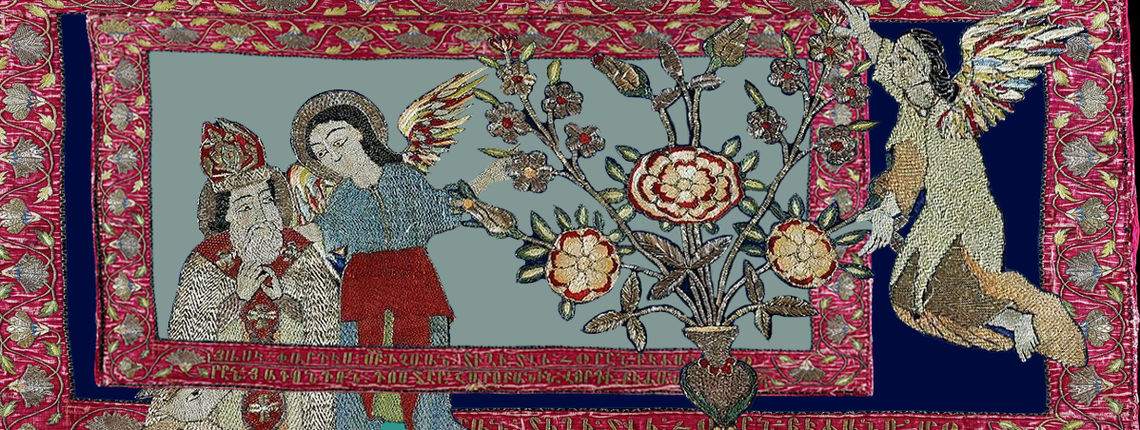Thu Nov 01 2018 · 8 min read
The Metropolitan Museum Puts Armenian Civilization Center Stage

By Christopher Atamian

Armenia! the groundbreaking exhibition that opened in New York City at the Metropolitan Museum of Art’s Byzantine galleries on September 22 asserts the full force and importance of Armenian cultural, religious and commercial contributions over a span of more than 14 centuries.
Curator Helen Evans begins her remarkable overview in the fourth century when Armenians converted to Christianity and developed their own unique alphabet, up until the 17th century when they controlled global trade routes from South East Asia all the way East through the Balkans into Western Europe. Evans is the Mary and Michael Jaharis Curator for Byzantine Art at the Met and specializes in Armenian art, having received her PhD from New York University’s Institute of Fine Arts with a thesis on "Manuscript Illumination at the Armenian Patriarchate in Hromkla and the West." She has lectured and published widely on cross-cultural currents in the development of Christian art, style and iconography and co-curated another blockbuster exhibition at the Met, “The Glory of Byzantium” in 1997 as well as “Treasures In Heaven: Armenian Illuminated Manuscripts From American Collections” at the Pierpont Morgan Library and the Walters Art Gallery in Baltimore in 1994.
The current exhibition is a pet project of sorts for the curator, who has called it “a culmination of a lifelong dream” to bring together medieval Armenian treasures from all over the world. Putting together the exhibition was no easy task. Funding came mainly from the Hagop Kevorkian Fund and a select few Armenian foundations such as the AGBU and The Hirair and Anna Hovnanian Foundation. Evans reached out to non-Armenian funding sources as well, including the Carnegie Foundation and the National Endowment for the Arts. But while the majority of the funding came from diasporan sources, the effort as a whole was truly pan-Armenian. Objects are on loan from the Republic of Armenia’s Mother See of Holy Etchmiadzin and the Matenadaran, as well as well as the History Museum of Armenia. The four corners of the Armenian Diaspora were tapped for sources as well, including the Calouste Gulbenkian Museum in Portugal which lent several items, along with The Holy See of Cilicia in Lebanon, the Armenian Patriarchate of Jerusalem, and the Armenian Mekhitarist Congregation in Venice. In the United States major contributions were made by the Diocese of the Armenian Church in New York, the Armenian Museum of America outside of Boston and the Alex and Marie Manoogian Museum in Southfield, Michigan. Additional works come from The Met and other American and European institutions. In several interviews, Evans has emphasized the amount of persuasion and negotiation that is required for institutions in far-off countries to lend out such treasures, even when the host museum is as prestigious and respected as the Metropolitan.
As the text to the exhibition notes, over the centuries Armenian merchants and clergy brought back to the Armenian homeland—an area that historically stretched from the Caucasus and the plain of Mount Ararat down past Lake Van into Cilicia and Anatolia, depending on the century—books printed in Armenian printing presses as far away as Amsterdam and India, as well as spices, textiles and other precious goods. It was during these Medieval centuries that Armenia—independent for only about a century in Cilicia—nevertheless sat at the crossroads of at least four powerful Empires: Greek Byzantium, Safavid Iran, Ottoman Turkey and Imperial Russia. Each one influenced the Armenians and the Armenians in turn influenced both neighbors and invaders.

Images from the Metropolitan Museum of Art offficial website.
At monasteries such as Dvin, Sis and Hromkla, vast scriptoria produced sumptuous illuminated manuscripts reminiscent of their Russian and Greek Orthodox counterparts but in a style and colors uniquely their own. Starting as early as the 14th century in Ottoman cities such as Kütahya and Iznik, Armenians craftsmen were in the vanguard and played a decisive role in the development of these two renowned schools of ceramics and tile making. In the Kütahya school of ceramics in particular, the presence of dragon motifs and others typical of Sino-aesthetics are indicative of the the fact that Armenians controlled trade routes all the way to China—the 18th Century Hexagonal Tile with Architectural Scene on loan here from the Manoogian Museum provides a strong example of Kütahya design.
Elsewhere in the exhibition, fascinating maps that depict far-flung trade routes and one that serves as a kind of yellow pages of Armenian churches around the world hint at the breadth of Armenian culture. The singularity of this particular show is to place the Armenian achievement within a global context. Incredibly enough, much of this art was created as Armenia suffered wave after wave of invasion—be it Byzantine, Arab, Persian, Mongol or Turkic. In the process the Armenians learned to create and thrive in the most adverse of circumstances. The exhibition itself is divided into five main galleries, each one dealing with a different era or subdivision of Armenian art. The first gallery recounts the historical conversion to Christianity in 341 and existing trade at the time, while another is devoted specifically to Armenian architecture and yet another to the Armenian Kingdom of Cilicia that bordered the Mediterranean around Adana and Adiyaman—today’s Cukurova province in Turkey. Armenian liturgical objects fill another gallery, while the remaining two are devoted Armenian trade routes in the Ottoman and Safavid Persian empires.

Images from the Metropolitan Museum of Art offficial website.
The 140 or so objects from all over the world are arranged by type, as well as century and place of origin. There are lovely photographs by Hrair Hawk Khatchatrian of some of the monasteries and other monuments, accompanied by texts that place them within the Armenian and global contexts. Some of the outstanding pieces on display include the many large carved stone khatchkars or sacred stone crosses from several centuries and regions. These will not be new to those familiar with Armenian art. Byzantinists and art historians—as well as lay viewers with an eye for detail or history—will note for example the fascinating iconography a 12th century khatchkar from the Lori-Berd region in Armenia depicts of the four evangelists who authored the Gospels. Saint Matthew’s angel presides over the those of Saint Mark’s lion (symbolizing strength and valor), Saint Luke’s ox, and Saint John’s eagle. Those people who have visited Armenia may recognize some of the liturgical works in the gallery devoted specifically to the monastery complex in Lake Sevan, including gorgeous church censers, which are assembled here with images of the church of Surb Arakelots, many of them donated over the ages by pious church members.
There are also some wonderful works that surprise for their diversity of style. A lovely silk tapestry with Dragons and Flowers (11th–12th centuries) recalls the finest Chinese carpets from the Far East. Through this seemingly mundane detail, one gets an idea of how a wealthy Armenian woman might have dressed from a lovely set of crescent-shaped earrings from the 11th century made of gold sheet, plain and twisted wire and from a well-crafted oval bracelet from the same period made of goldsheet, wire, niello, granulation, and bronze core. Both recall the finest Egyptian or European craftsmanship.

Images from the Metropolitan Museum of Art offficial website.
Armenian scriptoria at Gladzor and Dvin produced some of the finest examples of illustrated manuscripts to be found anywhere. Colophons identify the scribe and illuminator but also depict the patrons who included themselves in the illustrations—something unique to the Armenian tradition. Though this may appear somewhat self-aggrandizing, in retrospect it has been a godsend, as it has helped generations of manuscripts to be properly identified and categorized, and has contributed to piecing together other aspects of medieval Armenian history. Two gospel books from 1256 Hromkla made of tempera, ink, and gold on parchment are particularly noteworthy as are other works by Toros Roslin, perhaps the most famous painter of illuminated manuscripts in the Armenian tradition. There’s also a rare and particularly exquisite 6th century silver hanging Censer with Six Holy Figures from Constantinople on display.
While there is rarely if ever such a thing in the history of art as a pure or authentic style—Armenian or otherwise—some of the objects here can be distinguished by their integration of Mongol and Islamic stylistics and color schemes. Armenian families such as the Orbelians, Proshians, and Zakarians families amassed great wealth by controlling the Mongol trade routes during the Pax Mongolica (13th and 14th centuries) from China to the Mediterranean. Hence certain dragon motifs and pottery techniques, and even the facial features and clothing depicted on some objects obviously derive from this influence. Similarly several centuries later in the 1600’s the Armenian khojas of Nor Julfa in Persia (modern-day Iran) who had been forcibly deported by Shah Abbas because of their talent in trade and crafts, established sumptuous churches and produced artworks that bear a distinct Persian influence. A delicate 1650 depiction of Patriarch Hakob of Julfa painted by the renowned Safavid Persian artist Afzal al-Husayni in ink, opaque watercolor and gold on paper (20 × 15in) on loan from the Los Angeles County Museum of Art shows the man of God in deep bluish-purple vestments, with delicately drawn facial features—as well as the intricate stylistic links between Armenian and Persian art at the time. And a small thirteenth century white incised composite bowl less than eight inches in diameter, also from Persian Armenia looks as modern and sophisticated as recent Scandinavian or Chinese works.
Regarding the preponderance of religious objects and imagery, Evans has noted that this would be true of almost any medieval exhibition, since most art was commissioned either by the church or by wealthy families and royalty who presented them to their churches as pious Christians or who intended to curry favor with Rome or Constantinople, the respective seats of the Roman Catholic and Byzantine Orthodox Churches. In any case, Evans has certainly achieved her goal of taking a culture and tradition that was once subsumed into Byzantine or medieval studies and showing that it deserves its own separate but important place in the history of art and civilization along with others such as Venice, Rome, and Greece. And not surprisingly perhaps, Armenians today continue to travel the world, bringing their talents to the nations of its far-flung diaspora. It is a tradition, we learn in this exhibit, that goes back a long way and one which has contributed as much to world civilization as it has borrowed from it.


